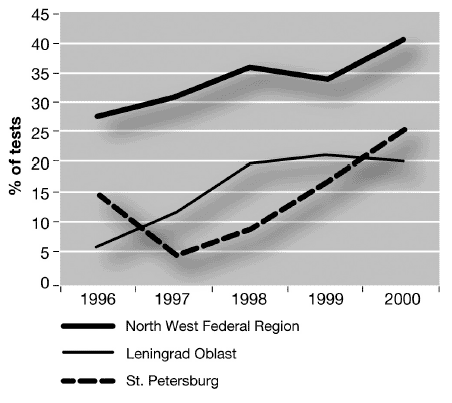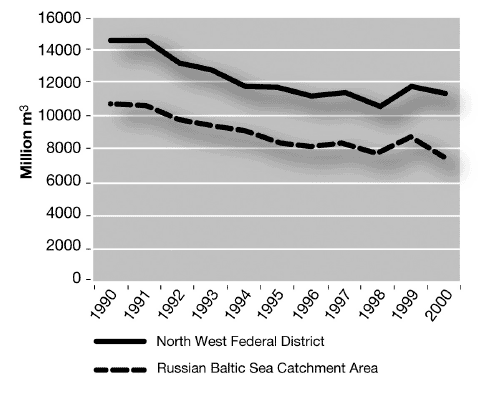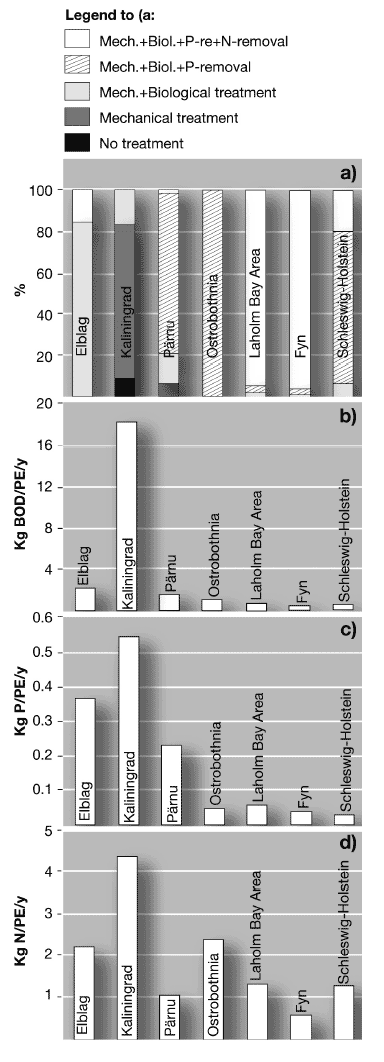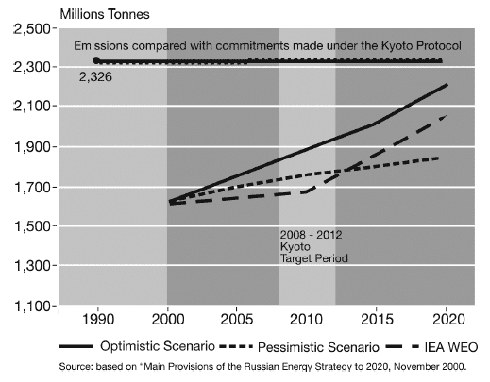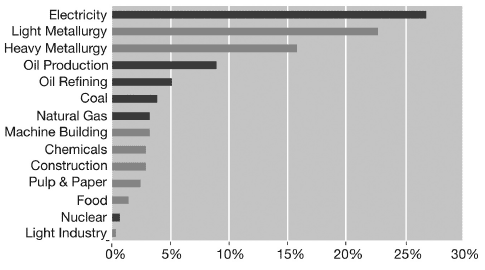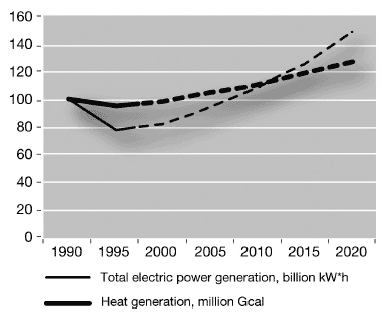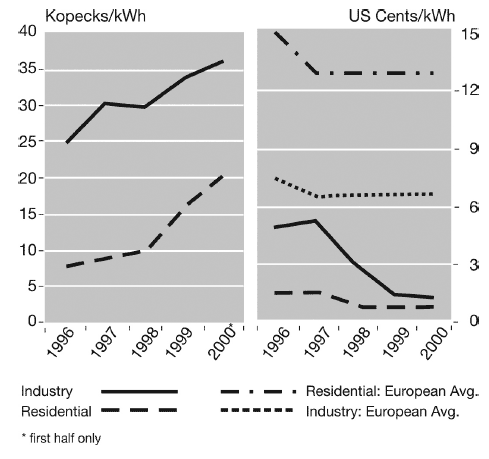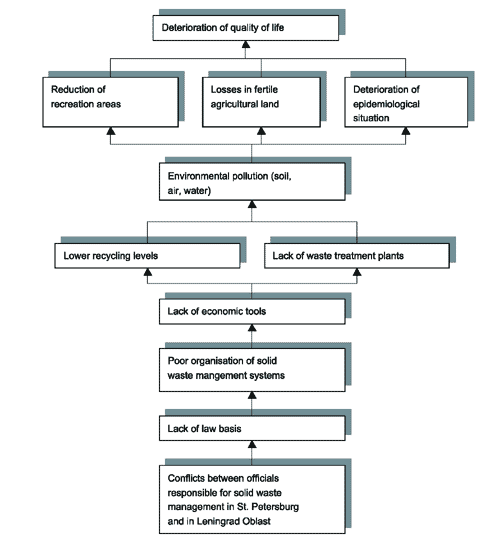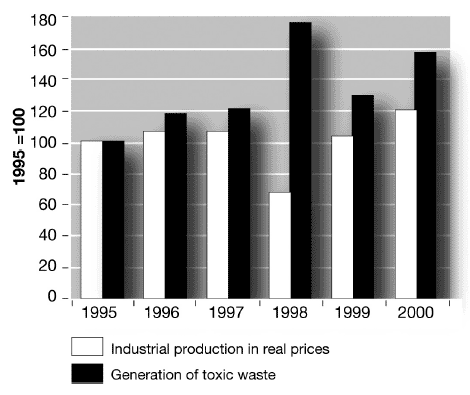|
Strategic Analysis of the Environmental Challenges for Northwest Russia 4. Sector Specific Environmental Challenges
During the Soviet period Russia maintained – as compared to e.g. West Europe – a high service level in urban areas concerning water supply and wastewater collection and treatment. The problem today is therefore not always lack of access to these services because of their nonexistence but the poor or non-functioning of systems mainly due to lack of maintenance. Much of the equipment is broken down or heavily energy consuming, whereas structures are of sufficient quality or can be rehabilitated. Therefore, rehabilitation and retrofitting existing plants could be more cost-efficient and in general be more adequate than investing in new plants. Public utility systems in the water sector are generally designed for capacities much above required levels and are thus inefficient. The following section focuses on problems related to protection of drinking water resources, water supply and wastewater disposal including collection, treatment and sludge handling. As signatory of the London Protocol, Russia is committed to address environmental and health problems related to water simultaneously. However, the implication of the present problems for public health is outlined first to illustrate the necessity to intervene now and in a cost-efficient manner.
www.helcom.fi, Press Release 27.04.01 4.1.1 Impact on public health Outbreaks of infectious diseases related to water supply or recreational waters are frequent in the Russia. According to WHO Regional Office for Europe, Russia had in year 2000 an infant mortality rate of 18 per 1000 live births, more than double of Western Europe and an under-five mortality rate from diarrhoeal diseases of 9.3, more than 10 times higher than Western Europe. In 1999, the Harvard School of Public Health conducted a detailed survey of the relationship between gastrointestinal diseases and microbiological pollution of drinking water in the City of Cherepovets, Vologda region. The study demonstrated that approximately 90% of adults had antibodies to cryptosporidium in their blood indicating a high frequency of exposure to this pathogen14. In August 2001, the Russian Security Council Commission on ecological security stated that drinking water quality in Russia is endangering human lives because of its contamination with industrial waste15 (from old dump sites). 4.1.2 Drinking water resources Drinking water resources are contaminated from the following sources:
Urban areas generally draw their raw water from surface water sources, whereas rural areas typically rely on shallow wells. About 60% of the population16 are supplied with water from surface water sources. According to the national classification of surface water, most Russian rivers and lakes are classified as "moderately polluted" or "polluted" and less than 1% can be abstracted without treatment. Within this classification the Neva River, the main drinking water supply source of St. Petersburg, is characterised as "polluted"17. In Northwest Russia 40% of the drinking water does not meet chemical standards and about 25% does not meet microbial standards18. Poor raw water quality due to bacteriological and chemical contamination of water sources, inadequate water treatment facilities and leakages in the distribution systems are seen as main reasons for not maintaining a safe drinking water supply.
Figure 4.1 * Including ponds, reservoirs, wells etc. Source: GOSKOMSTAT, 2001 4.1.3 Water supply The supply of water is facing the following problems:
As compared to the Soviet period, domestic water consumption in Northwest Russia has been reduced significantly reaching an average 245 litres /capita/day19. However, this level is still twice the consumption of western European countries. The major reason for this excessive consumption is an in-efficient distribution system with a high level of losses, leaking in-house fittings and wasting of stored water (preventive measure against interrupted supply) as well as an insufficient tariff structure not providing appropriate incentives for reducing consumption.
Figure 4.2 Source: GOSKOMSTAT, 2001 According to the National Environmental Action Plan for Russia, more than half of the country's water supply systems, including the central-ised water supply systems in virtually all cities and towns, need to be renovated or rebuilt. The present water losses are reported to be 40 -50% of the abstracted amounts of water, which is very high, compared to the levels of typical Western countries of 5 - 15%. The poor condition of the supply system is also reducing the water quality when contaminants are entering the pipe system at low (or negative) pressure. This situation occurs when the water supply is interrupted either during repair or when pumps are stopped to save energy. Intermittent water supply requires people to store water for periods of non-supply. This leads to risk of contamination during storage and poor hand hygiene as washing hands become unpractical (when you are used to having a tap). It also leads to wasting of excessive stored water when fresh supply becomes available.
Source: Danish Environmental Protection Agency project document, 2002 Water treatment plants do not sufficiently address the water quality problems of microbiological components like cryptosporidium (parasite). These parasites are a widespread problem in Russian water supply. Another problem encountered in many of Northwest Russia’s waterworks, using surface water, is pre-cautionary chlorination in the process of water purification, which leads to the formation of carcinogenic chlororganic compounds in drinking water. 4.1.4 Wastewater disposal Wastewater collection and treatment represent another major environmental challenge for Northwest Russia. About 55% of the Russian population is serviced by centralised wastewater collection and treatment systems. The wastewater treatment facilities need maintenance: Of the 76% of wastewater treated, only about 10% is treated according to required standards20. The main problems facing disposal of wastewater are:
Source: HELCOM Task force hot spots review Wastewater collection system The wastewater collection system (sewer network) in Northwest Russia is generally of a poor quality and has seriously deteriorated due to lack of repair and maintenance over a considerable span of years. Leaking sewers pose a considerable threat to aquifers and surface water bodies, endangering the drinking water supply. Sewer pumping stations face frequent breakdowns, which in combination with sewer blockages result in severe overflows. Wastewater treatment Urban wastewater Most of Northwest Russia's wastewater treatment plants is designed for mechanical and biological treatment for removal of organic matter. Generally, there is limited removal of nutrients like nitrogen and phosphorus. Most of the plants do not comply with required standards, which result in excessive pollution loads being discharged into receiving waters with subsequent risk of health hazards, eutrofication and oxygen depletion. The most widespread pollutants present in discharges into water bodies or catchment areas are oil products, suspended solids, nitrogen, phosphorus, synthetic surfactants, zinc and copper compounds, and phenols21. The treatment technology in Northwest Russian wastewater plants is, generally speaking, in line with internationally accepted principles as regards the process configuration. However, the plants suffer from severe lack of maintenance, obsolete and inefficient equipment and lack of appropriate control systems. Rural wastewater Wastewater treatment in the rural areas is characterised by low coverage by public utilities. A significant number of people living in rural areas are thus responsible on their own for handling and disposal of their wastewater. As the financial situation in rural villages is not favourable, the scope for improving or just maintaining local facilities is limited. Disposal of Sludge Sludge from wastewater treatment constitutes a severe threat to the soil quality and ground and surface water resources. The sludge is often poorly stabilised and previously contained large amounts of heavy metals and other toxic or recalcitrent substances. However, the decrease in industrial production has generally resulted in a substantial improvement of the sludge quality, thereby reducing the risk of contamination from sludge presently produced and disposed of. Where sludge is still stored in lagoons it imposes a risk of contamination of streams and rivers due to frequent overflows of aquifers and due to pollutants seeping into the ground. 4.1.5 Energy consumption in the water sector Energy consumption in wastewater pumping stations is generally excessive due to inefficient control measures, inadequate pumping equipment and lack of maintenance. The energy consumption is estimated to be two to three times larger compared to corresponding western installations of similar capacity and nature. The efficiency of wastewater pumping stations reaches only 15-20%, and electricity over-consumption for all Russia amounts to 2.5 billions kWh annually22.
Figure 4.3 Source: Strategies for improved Eutrophication Management in the Baltic Sea Region, Bernet., p. Energy consumption for groundwater pumping, water treatment and supply exceeds by a factor 2 to 3 the kWh/m3 needed when using modern pumping equipment combined with efficient operations control. Investments in pump replacements often have a payback period of less than 5 years. One reason is that pumping stations in Northwest Russia are not usually equipped with special devices regulating their output upon demand, and the regulation of output is carried out by manual operation of valves. As a result, the efficiency of the pumping station does not exceed 35-40%. For all Russia, the annual electricity losses amount to 5-5.5 billions kWh due to this reason only.
The low level of revenue generated from the user charge payments is the core of the financing problems experienced by the water utilities.
Source: OECD, Danish Environmental Protection Agency: "Short Justification for the Municipal Water and Wastewater Financing Strategy, Pskov", 2001 4.1.7 Natural Resource Management When analyzing the challenges faced in the water sector, there is an urgent need to understand the interrelationship between these challenges and issues related to biodiversity and Natural Resource Management. Problems concerning biodiversity and nature protection include amongst other resource extraction and pollution, poorly planned and executed commercial forestry, construction and transport activities, insufficiently regulated hunting. Furthermore, these problems are aggravated by uncertainty about future ownership of land and resources and low environmental awareness among administrative staff, decision-makers, and the general public. Also, regional policies are lacking realistic implementation plans, and common principles and standards for resources management including overall strategy for development of protected areas, Ramsar sites etc. The planning is impeded by a lack of cost effective environmental monitoring systems which are able to provide reliable data and information for use in planning, management and conservation of natural resources. There is a need to improve spatial planning/landscape planning tools to adequately preserve natural resources as eg. water bodies, streams and lakes, incl. ground water protection. The point of departure should be a holistic approach, with comprehensive co-ordination and co-operation between relevant regional and local authorities which would also be a mean to allocate resources more effectively. Capacity building in North West Russia's environmental administrations with particular focus on implementation of international conventions and agreements relevant to nature protection is essential. Networking with other international protected areas should be encouraged as a mechanism for capacity building of protected areas staff. 4.1.8 Facing the challenges in the water sector Because of the close interrelationship between wastewater disposal and water supply the concept of total water management must be empha-sised in Northwest Russia. Part of this concept is to prioritise investment to ensure the best use of the limited resources. Proper planning and investigations of perceived problems like groundwater pollution or a health impact can confirm a problem or on the other side lower the priority for an intervention. Furthermore, the total water demand concept demands for efficient water demand management to ensure lower water consumption and economically and environmentally suitable management of utilities. Financing strategies carried out for the regions of Pskov and Novgorod also pointed to the need for strategic investments in energy saving equipment as well as renovation of the water supply networks and other water saving initiatives, including lower consumption levels. Relatively small pilot interventions in this area should be implemented to effectively demonstrate needed win-win solutions, that brings down operational expenses and hence have a short payback period. Finally, the total water management concept demands for:
With regard to rural areas, individual water supply and wastewater disposal systems should be centralised only when found both financially and environmentally feasible, as individual systems are not necessarily a prioritised environmental or health problem. Concerning health issues, there is a need to identify more precisely which infectious diseases are related to water quality and how they are most efficiently addressed. Similarly the chemical components that locally are having a potential impact on public health should be identified and monitored. As laboratories in Northwest Russia at present can not analyse all drinking water standards, "problem" components must be identified and subsequent interventions should be initiated at the most efficient place. Some components must be removed at the source where others must be removed at treatment plants or prevented from entering supply systems. It should be noted that contamination of sludge by heavy metals and other industry related toxic or otherwise dangerous substances must be handled at source i.e. at the industries. The technical solutions for solving the problems and obstacles within water supply, wastewater collection and treatment are well-known and well-proven technologies exist, for instance:
Source: Press-Service of the Ministry of Natural Resources of the Russian Federation, Jan 16, 2003. Areas of particular relevance for international co-operation Within the water sector, the following international environmental agreements are of particular relevance to co-operation, as Russia is signatory to all three:
The international co-operation regarding these three international environmental agreements has received significant attention in the Russian co-operation already, and this effort should be maintained or even further improved. Furthermore, future co-operation in the water sector shall be seen as a building block in the regional EU Water Initiative (WI) for the EECCA23 region which was agreed on at the World Summit on Sustainable Development in Johannesburg in September 2002. The new regional TACIS programme has as a specific objective implementation of the EU WI focussing on water supply and sanitation as well as integrated water resources management and transboundary waters. 4.2 Environmental Challenges in the Energy SectorSerious environmental challenges are related to the energy sector in Russia. These include specific environmental problems caused by air pollution and waste handling (see chapter 4.3), and excessive natural resource consumption due to inefficient use of energy. Air pollution causes a wide range of health, environmental and socioeconomic impacts. While some air pollution problems have local causes and impacts, such as within an urban area, other problems have regional or global implications. Table 4.1
(+) indicates indirect source Table 4.2
(+) indicates indirect impact Russia has extensive fossil energy resources. Besides supplying its own consumption of fuels – energy exports, particularly oil and gas, account for the main part of export income to Russia. In domestic consumption coal accounts for 16% of the fuel consumption, natural gas for 54% and oil for 19%. Historically, for various reasons (cheap energy, huge distances, severe climate, large proportion of energy intensive industries in the national economy) energy consumption in Russia has always been very high. The Russian economy is dominated by large energy-intensive industries. Furthermore energy use is in generally inefficient as compared to international norms due to low energy prices, lack of metering and controls and lack of market incentives to reduce costs. 4.2.1 Energy-related global and local environmental problems Global/regional Global and regional environmental problems related to energy production and conversion include emissions of CO2 and other green house gasses and emissions of air pollutants leading to acid rain and eutrophication with transboundary implications, for instance affecting the environment of the Baltic Sea. Russia has met its international commitments to reduce its emissions of SO2, NOX, and CO2. However, the reduction in emissions relates to the decline in the Russian GDP, and the emission reductions have even been slower than the decline in GDP. The energy sector contributes with 90% of all green house gasses emissions in Russia. If Russia ratifies the Kyoto Protocol it commits itself to maintain its emissions of CO2 and other greenhouse gases in 2008-12 at the same level as in 1990. The decline in the Russian economy following the transition of the economy has already reduced the energy consumption significantly and the country is expected to be in a position to sell carbon credits to other countries that are not able not meet their targets domestically.
Figure 4.6 Source: IEA 2002, p. 262 Even though Russia has reduced its emissions they still amounted to 11 tonnes of CO2 per capita in 2000. This is similar to e.g. Denmark, but remarkably high considering that the GDP/capita is 10-15 times lower in Russia. The low energy efficiency in Russia also results in high CO2 emissions when compared to other countries.
Figure 4.7 Emissions include SOx CO NOx Methane, VOCs and Particulate
matter. Source: IEA 2002, p. 245 Details on the individual emissions from the energy subsectors are provided in the table below. Table 4.3
* Comparison of coal sector emissions of methane is far 1994-1999. Local/regional Apart from the global implications on the environment, energy production has other negative side effects. The establishment of energy plants and the disposal of by-products from energy production represent an environmental problem for the local environment, but can also have regional implications as pollution is washed into the Baltic Sea (see chapter 4.3). Health Impact During the first half of the 1990s pollution levels exceeded Russian air quality standards (maximum allowable concentration) in cities covering 62% of the Russian population. One-third of the entire population lives in areas with high pollution peaks. Emission per unit of GDP of SOX, NOX, particulates, CO, VOCs, and CO2 have all increased during the 90s and remain much higher than the OECD average.
OECD Environmental performance review, p. 56 The severe air pollution leads to high frequencies of respiratory diseases in Russian cities24. 4.2.2 Energy consumption and conversion Excessive energy consumption and losses in energy conversion and supply are at the core of the energy related environmental problems in Russia. The Russian energy consumption in 1999 totalled 6.8% of world total25, making Russia the third largest energy consumer after USA and China. The industrial sector accounted for 65% of the consumption, the remaining was split evenly between transport and residential sectors. Energy consumption Households heat and hot water consumption are high – not only due to Russia’s severe climate – but to a higher degree due to technical deficiencies and inadequate behaviour. Consumers cannot control their individual heat consumption, as there are often no thermostatic valves on the radiators as central heating systems are normally one-stringed. At the same time they also lack incentive to reduce consumption of heat and hot water, as billing is often independent of the actual consumption of the individual household. Industries in Russia are very energy intensive, which is reflected in an overall energy intensity of the country of 84 MJ/$ GDP in 2000, compared to for instance 12 MJ/$ GDP in USA. Energy consumption in industry includes district heating, electricity and primary fuels. Historically low energy prices paved the road for heavy energy intensive industry and little awareness to energy efficiency and officially required energy standards. Inefficient design and control measures, inadequate pumping equipment, leakages and insufficient insulation of boilers and pipes often result high electricity and heat consumption in industries. Further more overdimensioning of pipes, valves and pumps often causes electricity consumption for pumping purposes to be very high compared to western systems. Energy networks District heating networks are gradually deteriorating due to lack of maintenance (e.g. leakage and poor insulation of pipes) and reinvest-ments, and some 15% of the pipes in Russia need urgent replacement. This results in increasing heat and water losses from the networks. The consequence is heat losses that on the average are assessed to some 30%. Emissions and leakages from the oil and gas industries are of significant environmental importance. Emissions of CO2 and leakages of natural gas from production sites and the pipes of the national gas company Gazprom alone accounted for 11% of the total CO2 emissions in Russia in 199926. Energy Conversion Power generation in Northwestern Russia amounts to 5.6% of total power generation in Russia and is distributed on thermal power production (coal, gas and oil) 33%, hydro 18%, nuclear 41% and others 9%. Coal is playing an increasing role as fuel for power production in Russia, and this is expected to continue at the expense of gas and oil as fuel. The recent economical recovery has resulted in increased electricity consumption in households and industries. Most power plants in Northwest Russia are obsolete by Western standards and seriously need maintenance and upgrading, resulting in low efficiency power plants. If investments stay at the present low level, 32% of the current generating equipment is forecasted to be out of commission by 2005, which may give rise to crisis in electricity production and lead to regional power shortage27.
Figure 4.8 Source: Energy Strategy of Russia (1990 index 100) District heating consumes about 280 million tons of oil equivalents, corresponding to about 44% of Russia's total fossil fuel demand. The overall energy efficiency of combined heat and power plants production in Russia is around 75-80%. When comparing with international best-practise it should be possible to reach efficiencies in Northwest Russia of not less than 90% which would imply a reduction in fuel consumption and emissions of at least 25%. However, rehabilitation of district heating systems and introduction of decentralised solutions will entail huge investments, which are also needed to remove pollutants from flue gases of central heating plants and boiler stations. 4.2.3 Energy sector reforms and strategy In 2001, the Main Provisions of the Russian Energy Strategy to 2020 was approved by the Russian government. The Strategy provides an overview of problems facing the energy sector and resolutions needed to support general economic growth and reform. However, due to criticism as to the reality of the implementation of the Strategy a revised version is presently under preparation.
Organisational and financial difficulties are at the heart of the environmental problems in the energy sector and need to be addressed. Difficulties arise in the interface within the energy sector and between energy companies and consumers. Fuel prices Low fuel and energy prices have a long history in Russia and this has negatively influenced incentives for heat and power plants, industries and public utilities to increase energy efficiency. Tariffs In the Energy Strategy, tariffs were planned to increase to cover longterm costs by 2010. In reality, however, the tariffs recently approved by government on gas and electricity as well as the planned increases announced for 2003-2005 fall significantly behind the tariffs envisaged by the Energy Strategy. Table 4.4
1. Average for households and industry in Russia Sources: Energy Strategy of Russia, EIA 2002, p.209, and data collected by COWI Moscow The tariffs on electricity for Russian industries are higher than for households and traditionally large cross subsidies have been provided from industry to the residential sector.
Figure 4.9 Source: IEA 2002, p. 209 Lack of funding Similar to the public utilities in the water sector, energy companies lack funds to finance maintenance and investments. Tariffs typically only cover operational costs, i.e. fuel, operation and limited maintenance costs.
15% of Russia’s energy production originates from 9 nuclear power plants with 29 reactors in total. While European countries as Sweden, Germany, Belgium and the Netherlands are aiming at a downscaling their present levels of nuclear power production, Russia is expanding its nuclear power production capacity. Russia is currently planning to upgrade/renovate a number of reactors and plans to construct five new reactors in the coming 5 to 7 years and additional 10 reactors in the following 10 years28. The realisation of these very ambitious plans is threatened by lack of financial resources. Minatom receives limited revenue for the electricity delivered (65% in 2000) and consequently the investments are only 20% of what was originally planned. The major non-paying consumers are mainly state-owned companies. It is the declared objective of the Minister of Minatom that Russia should be an important player on the international market in relation to nuclear issues. Russia exports nuclear power plants to, amongst others, China, India, Iran, and exports uranium and electricity and has lately started to receive used nuclear fuel for storage. International support A long range of countries have on a bilateral basis been involved in tackling the nuclear problems Russia faces and e.g. the US has contributed with 7 Billion USD since 199229. The EU and Russia are currently negotiating on the terms for a "Multilateral Nuclear Environmental Pro-gramme in the Russian Federation (MNEPR)" which is supposed to become the framework for donors who seek to contribute to the nuclear stability and safety in Northwest Russia. However, it has not yet been possible to conclude this agreement. In the summer 2002, the Northern Dimension Environmental Program-me pledged Euro 62 Million earmarked for nuclear projects in Northwest Russia including handling of spent nuclear fuel (see chapter 4.3.6). However, the implementation of these projects is dependent on the successful signing of the Multilateral Nuclear Environmental Programme in the Russian Federation. Safety The 1986 Chernobyl disaster is a clear illustration of the risks connected to old and worn-out nuclear power plants. Today, 16 years later nuclear generated power still represents an important part of Russia’s energy production and although the safety-conditions in the Russian nuclear power plants have been considerably improved during the 1990s they still give rise to concern30.
www.bellona.no 4.2.6 Facing the challenges in the energy sector Reduced energy consumption and increased efficiency in energy production and supply are the most efficient ways – and must be pursued – to reduce the environmental and health problems caused by the sector. This calls for establishing an institutional and financial set-up that provides these means and incentives. Tariff setting must reflect the real longterm cost of producing and supplying energy and natural gas. This requires that:
In the heat sector, installation of control equipment, meters and billing according to consumption should be introduced both in the domestic, industry and service sectors. This calls for:
Most energy plants in Northwest Russia are in a serious state of disrepair. It is pivotal that sufficient financial resources be allocated to this sector to avoid more or less permanent regional power shortages in the coming years, which would have significant negative impact on the economical activities in Northwest Russia. Tremendous spills and leakages from pipelines losses further aggravate the situation and preventive measures should be taken. Furthermore, increasing oil export on tankers through the Baltic Sea poses a higher risk of accidents and oil spills if no additional measures are taken. This demands for:
With regard to nuclear energy, replacement of first generation RBMK reactors is urgently needed as these are classified as being amongst the most unsafe in the world due to outdated technology. Also contingency plans and more efficient monitoring systems should be developed. Areas of particular relevance for international co-operation Co-operation could include preparatory work still needed for Russia's signing of the Kyoto Protocol e.g. technical support, awareness raising and demonstration activities Furthermore, the scope for Joint-Implementation activities should be pursued. Finally, Russia should further strengthen its international alliances and efforts toward fulfilling the obligations of being signatory to the Geneva Convention on Long-Range Transboundary Air Pollution as well as the Vienna Convention on Protection of the Ozone Layer, specifically the Montreal Protocol and its amendments. 4.3 Environmental Challenges in the Waste SectorThere are several critical environmental impacts linked to the practises for handling waste in Northwest Russia. Deficient waste management has a major bearing on the state of the environment in the Baltic Sea and on issues related to water quality, soil pollution, and human health. A number of the HELCOM hot spots in Russian territory are in fact related to waste issues, and are attributable directly to waste management plants or industries’ discharge of various hazardous substances. 4.3.1 Municipal solid waste In Northwest Russia, municipal solid waste31 is almost exclusively disposed of in landfills that do not meet requirements and are subject to growing capacity constraints. There is very little focus on waste minimi-sation and recycling. The legal framework for activities related to municipal solid waste was established during the Soviet period. Most Acts and Ordinances adopted before 1991 are still in force. For instance, sanitary norms and rules (Sa-nPin), State Standards (GOST) established requirements to the Municipal Solid Waste landfills and municipal services involved in waste collection. In order to promote a new legal basis, the Federal Law "On waste of production and consumption" was approved in 1998. Based on this Law a number of new governmental Acts must be adopted. Waste collection Urban solid waste collection equipment and transfer stations work fairly well in the sense that main streets are generally kept clean. However, there are suburban and rural areas, which are not serviced by regular collection services, which mean that residents must resort to illegal dumping of waste. There are problems related to an outdated system of waste collection and storage within and near houses, which requires a lot of manual labour for waste handling, creates unsanitary conditions within multistorey apartment houses and around collection points because of odour and contamination of surroundings by waste. As a result of improper management, waste is readily accessible to rodents, flies and other insects, which creates a nuisance and risk for human health. There is a widespread lack of organised collection and treatment of Household Hazardous Waste (e.g. used accumulator batteries, PVC, mercury lamps etc.). Consequently, these categories of waste are either not collected, or disposed at unauthorised dumps or at municipal facilities not equipped to handle this waste segment properly. Recycling Modern waste management practices such as separate collection, recycling and recovery are almost non-existent in Northwest Russia. In St. Petersburg approximately 15% of the solid domestic waste is recycled32. Landfill capacity Many Northwest Russian landfills operate close to their maximum capacity and the environmental quality of the facilities is low. Many dumpsites are poorly situated both geologically and geographically. They are not properly designed, constructed and operated:
The poor condition of Municipal Solid Waste disposal facilities contributes to negative environmental impacts such as soil, surface and groundwater contamination, air pollution (including dioxin production), odour and damage to landscape.
Source: Proceedings, EcoTech, Sweden, September, 1999 Northwest Russia’s treatment facilities do not comply with international or Russian Standards. St. Petersburg has two treatment plants, which treat approximately 30% of the domestic waste. An example of the waste problems is insufficient quality of the compost produced, which contains too high levels of plastic and glass material. At one of the St. Petersburg treatment plants 7 years of production is accumulated on the site33. Unauthorised dumping Insufficient waste collection systems lead to a high level of unauthor-ised dumping. In St. Petersburg City and Leningrad Oblast there are approximately 75 registered landfills but also approximately 1,000 unau-thorised dumps of various size34. Lack of control of waste streams There is a lack of continuous (from top to bottom) control of the waste streams from their places of origin to final operations on their disinfecting and recycling. The main causes of these shortcomings are a weak institutional and legal framework combined with a widespread lack of co-operation both between the subjects of Northwest Russia and between the various municipalities. Privatisation Even though a privatisation process has been pursued, a de facto monopoly situation is still the case in many places in the waste sector, even if private enterprises have taken over provision of most of the service. These companies are either owned by the public authorities or privately owned (or a combination) and it appears that open tender procedures based on real competition is not common.
Figure 4.4 Source: St. Petersburg Research Centre "Single Policy in Solid waste Management in St. Petersburg and in St. Petersburg City. 4.3.2 Industrial hazardous waste Waste Generation The most urgent environmental concerns in Northwest Russia are related to industrial hazardous waste. In spite of the general decline in industrial production during the 1990s and specifically the economic crisis in 1998, annual industrial hazardous waste quantities are not reported to have fallen during the period. The Russian industry generates more hazardous substances in the industrial processes than European industries.
Figure 4.5 * Industrial production in real prices, using the consumer price index for the area as deflator Source: GOSKOMSTAT, 2001 Waste disposal In the former USSR the problem of hazardous waste was usually solved in a very simple way, i.e. by disposing such wastes in special landfills. Many of these hazardous waste landfills still exist and in many cases they are the only place where it is officially allowed to bring hazardous wastes. Between 1970 and 1990 a number of hazardous waste incineration plants were built all over the Soviet territory. Such incineration plants were usually constructed near e.g. major industries and big chemical plants and were only capable of treating liquefied wastes. Moreover, none of them were designed for PCB destruction. After 1991, most incineration plants were closed down for economic reasons, though some are still in operation. However, nearly all of them require fundamental modernisation and upgrading to meet international environmental standards. In Northwest Russia, there are also cases of hazardous waste being dumped at disposal sites for municipal solid waste although they are not equipped for this purpose – because no proper site for hazardous waste is available. Also, industries often do not separate and treat their hazardous waste according to the environmental requirements. In such cases the hazardous substances are discharged with industrial waste-water into surface waters.
Source: TEC Case Study, Courtney M. Nero (May 1999) Large accumulations Capacities of recovery and disposal facilities for hazardous waste in Northwest Russia are by far sufficient to cover the present needs. Therefore, large accumulations of industrial and hazardous waste are growing at industrial sites, particularly in the metallurgical and power generation industries. By the year 2000, it is estimated that more than 120 million tonnes of hazardous waste have accumulated in Northwest Russia35. As a comparison, the facility serving the entire territory of Denmark, i.e. more than 5 million people, treated about 110,000 tonnes of hazardous waste in 2000. The accumulated amount of hazardous waste in Northwest Russia, hence, constitutes more than 1,000 times the annual treatment capacity of this facility36. Improper storage The industrial hazardous waste accumulated at industrial sites or deposited at old hazardous waste landfills in Northwest Russia represent a major environmental problem as the waste is seldom stored in an environmentally safe manner. Hence, there is a risk of dangerous substances seeping into, or being washed out from storage sites and polluting the soil and ground and surface waters, thereby endangering drinking water resources and human health. In the Leningrad region, the official hazardous waste disposal site does not meet environmental requirements (see Box 3.1). Around 800,000 tonnes of unprocessed industrial hazardous waste, such as chlorinated substances and heavy metals are improperly stored in open pits37. This implies a serious risk of soil and ground water contamination, and stormwater may cause substances to wash into the Neva River and thereby the Gulf of Finland.
Source: Committee of natural resources, environmental protection and environmental safety of St. Petersburg administration, DEPA project documents 2000- 2002 Kaliningrad has similar problems related to storage and processing of hazardous waste, however, on a smaller scale. Today 6,000 tons of hazardous industrial waste is deposited in temporary storage houses that were not designed for this purpose. The risk of hazardous substances leaking into the ground is considered very high38. 4.3.3 Persistent Organic Pollutants (POPs) Effects of POPs Of all the pollutants released into the environment every year by human activity, POPs are among the most dangerous. They are highly toxic, causing an array of adverse effects, notably chronic diseases, and birth defects among humans and animals. This report will briefly describe the 3 categories of POPs: POP pesticides, PCBs (industrial POP) and Dioxin.
Northwest Russia has large stocks of POP pesticides to be dealt with in the future (estimated 21,000 tonnes), though exact figures are not available. PCBs Another important POP is the PCBs, which were produced by two factories in the former Soviet Union. From 1939 to 1993, the factories produced a total of about 180,000 tonnes of PCB39. It is estimated that some 17,000 tonnes can be found in transformers and 7,000 tonnes in capacitors. Amap estimates in its report "PCB in the Russian Federation" that between 1000 and 2000 tonnes of PCB is stored in PCB containing equipment in the Northwest Russian territory40. From the point of view of collection or substitution, the transformers are probably the application areas offering the highest "cost-benefit" ratio with the present plans for incineration41. Dioxins and Furans Dioxin and Furans are by-products of e.g. incineration of POP pesticides, PCB and waste
in general. A large scale US-Russian project provides estimations of dioxin emissions by
different sources. According to the inventory, total annual dioxin emission to the air
from Russian sources was estimated to be within the interval of 6900 to 10900 g I-TEQ
(International The most urgent problems regarding dioxins in the Russian federation have until now been pollution within and around chemical plants producing chlorinated and brominated compounds. When considering 3 of the most polluting chemical plants, each of them have an emission about 10 times higher than the entire Danish emission (all sources included). In Russia domestic waste is primarily deposited at landfills, often together with industrial wastes. Smoking landfills can be seen in many Russian regions all year round. Often landfills are set on fire in order to reduce the volumes of waste. No quantitative estimates of Dioxins and Furans formation from burning landfills are available but there are reasons to believe that such formation is not less hazardous than emissions from the waste incineration plants and the burning of landfills represents thus an environmental challenge that should be dealt with. 4.3.4 Financial challenges in the waste sector Tariffs The waste sector in Northwest Russia is in dire need of heavy investment in order to overcome the challenges indicated in the above sections and establish an environmentally sustainable waste management system. Tariffs are collected by the Municipalities/City administrations, but there are a series of problems related to the collection of tariffs which is similar to those identified in the water sector (see section 4.1).
Oil spills and leakage The Russian oil and gas industries are responsible for spills and leakages that contaminate soil and waters in many areas. Environmental standards are not enforced and international petroleum standards are not yet in place. Spills arise from pipeline leakages, accidents and tanker spills. Additional refinery capacity has been established in St. Petersburg and the export of Russian oil products through the Baltic Sea is planned to triple within the coming years. Consequently, the risks of accidents and of oil spill will increase if measures to reduce these risks are not taken. In total, more than 39 thousand ha of Russian land are contaminated with oil products of which military sites accounts for more than 70 per cent43. It is estimated that over 3 billion roubles (2001 prices) or more than USD 100 million are required only for the priority clean-up activities. A significant part of these military sites are located in Northwest Russia, though, more detailed studies are needed to assess the full volume of this problems and the impact on the environment in particular on the ground water, local and regional water bodies.
Source: National Report on Status of the Environment, Russian Federation, 2001 Waste from energy production Concrete examples of waste problems related to establishment of energy plants and the disposal of by-products from energy production in Northwest Russia are:
Construction of several new refineries, pipelines and oil terminals in the region in order to be able to ship out more crude oil and oil products in the Baltic Sea and the Barents Sea constituting increased risks of oil spills and adverse impacts on sensitive habitats. 4.3.6 Spent Nuclear Fuel (SNF) Storage and reprocessing of used fuel Apart from the safety issues relating to the nuclear power plants there are a series of problems relating to storage and reprocessing of Spent Nuclear Fuel and other contaminated wastes. The only facility for reprocessing used fuel is the Mayak plant which is situated in the southern part of the Urals. Thus, the used fuel is transported from all over Russia to this plant which has severe security related implications. However, Mayak is not capable of treating all types of used fuel elements produced in various nuclear powered generators and nuclear power plants. Furthermore, long-term storage facilities are not available and approximately 14,000 tonnes of spent nuclear fuel is stored at Mayak and at various plants44. OECD estimates that approximately 1 billion tons of high and low level radioactive waste is stored in Russia. However, the larger part is related to low-level radioactive waste from uranium and thorium mining and processing.
www.bellona.no The naval nuclear decommissioning Northwest Russia is awash with laid-up nuclear powered submarines and ice-breakers waiting to be decommissioned. Out of the 248 nuclear submarines built by the Soviet Union and Russia for the Northern and Pacific fleets, 191 are laid-up. 115 of these are located in Northwest Russia, of which only 32 have been dismantled. Only 10 submarines have been defuelled and 71 are laid-up with spent nuclear fuel onboard45.
Source: The Russian Northern Fleet: Handling of Spent Fuel Assemblies, Bellona, 2002 Another source of nuclear waste is spent strontium-90 fuel used to power lighthouses in the northern region. This method of powering lighthouses was also tested in the west but abandoned since it was difficult to ensure the safety of such large sources at remote and isolated locations. The source from lighthouses no longer in use is now taken care of with international assistance46. 4.3.7 Facing the challenges in the Waste sector Russia should continue the work towards creating an efficient legal and institutional framework for the waste sector. Russia’s waste handling strategies should relate to internationally recognised principles for waste management i.e. the "waste hierarchy" (highest priority given to prevention, followed by recovery and lowest priority to safe disposal). Within these principles, special efforts in Northwest Russia should be given to:
The technical challenges related to the waste sector are extensive but not insurmountable in the sense that well known and more or less technology intensive solutions are available.
Areas of particular relevance for international co-operation As signatory to the Basel Convention Russia should continue pursuing that a) transboundary movement of hazardous waste should be reduced to a minimum, b) hazardous waste should be treated and disposed of as close to their source of generation as possible. c) hazardous waste generation should be reduced and minimised at the source. Furthermore, Russia participated in the preparation of the 1998 protocol to the Convention on Long-range Transboundary Air Pollution on Persistent Organic Polluters, but has not signed it. One reason is the requirement to phase out PCB use by 2005, which is causing difficulties. The 1999-2001 "National Environmental Action Plan" does not consider Persistent Organic Polluters elimination (among air pollution problems, phase-out of leaded petrol is given the highest priority). Russia should continue working towards ratification of the Stockholm Convention on Persistent Organic Pollutants (POPs). Examples of specific activities envisaged within the preparatory process are:
According to Russian targets set in the Partnership and Co-operation agreement with the EU Russia should approach various EU regulations as e.g. The EU Waste Management Strategy (COM (96) 399) and the EU Landfill Directive (1999/31/EC). Finally, safe handling of nuclear waste demands for close international co-operation, as Northwest Russia apparently is not able to handle the situation. Dependent on the successful signing of the Multilateral Nuclear Environmental Programme in the Russian Federation, Euro 62 Million have been earmarked for nuclear projects in Northwest Russia under the Northern Dimension Environmental Programme.
|
||||||||||||||||||||||||||||||||||||||||||||||||||||||||||||||||||||||||||||||||||||||||||||||||||||||||||||||||||||||||||||||||||||||||||||||||||||||||||||||||||||||||||||||||||||||||||||||||||||||||||||||||||||||||||||||||||||||||||||||||||||||||||||||||||||||||||||||||||||||||||||||||||||||||||||||||||||||||||||||||||||||||||||||||||||||||||||||||||||||||||||||||||||||||||||||||||||||||||||||||||||||||||||||||||||||||||||||||||||||||||||||||||||||||||||||||||||||||||||||||||||||||||||||||||||||||||||||||||||||||||||||||||||||||||||||||||||||||||||||||||||||||||||||||||||||||||||||||||||||||||||||||||||||||||||||||||||||||||||||||||||||||||||||||||||||||||||||||||||||||||||||||||||||||||||||||||||||||||||||||||||||||||||||||||||||||||||||||||||||||||||||||||||||||||||||||||||||||||||||||||||||||||||||||||||||||||||||||||||||||||||||||||||||||||||||||||||||||||||||||||||||||||||||||||||||||||||||||||||||||||||||||||||||||||||||||||||||||||||
